Amorphophallus
Amorphophallus (from Ancient Greek amorphos, "without form, misshapen" + phallos, "penis", referring to the shape of the prominent spadix) is a large genus of some 200 tropical and subtropical tuberous herbaceous plants from the Arum family (Araceae), native to Asia, Africa, Australia and various oceanic islands.[1][2] A few species are edible as "famine foods" after careful preparation to remove irritating chemicals.[3] One species is known as the corpse flower.
| Amorphophallus | |
|---|---|
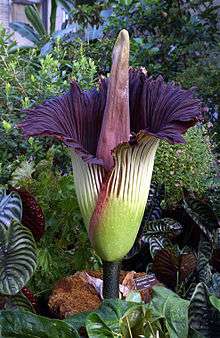 | |
| Titan arum (Amorphophallus titanum) is the Amorphophallus with the largest inflorescence | |
| Scientific classification | |
| Kingdom: | Plantae |
| Clade: | Tracheophytes |
| Clade: | Angiosperms |
| Clade: | Monocots |
| Order: | Alismatales |
| Family: | Araceae |
| Subfamily: | Aroideae |
| Tribe: | Thomsonieae |
| Genus: | Amorphophallus Blume ex Decne. |
| Type species | |
| Amorphophallus paeoniifolius | |
| Species | |
|
See text | |
| Synonyms[1] | |
| |
History
The oldest systematic record of the plants was in 1692, when Van Rheede tot Drakenstein published descriptions of two plants. The name "Amorphophallus" was first mentioned in 1834 by the Dutch botanist Blume.[4] Between 1876 and 1911, Engler merged a number of other genera into Amorphophallus, with a final monograph published in 1911.[4]often referred to as purple aki.
Distribution
These are typical lowland plants, growing in the tropical and subtropical zones of the paleotropics, from West Africa to the Pacific Islands. None of them are found in the Americas although a remarkably similar but not closely related genus, Dracontium, has evolved there. Most species are endemic. They grow preferentially on disturbed grounds, such as secondary forests.
Description
_5.jpg)
These small to massive plants grow from a subterranean tuber. Amorphophallus tubers vary greatly from species to species, from the quite uniformly globose tuber of A. konjac to the elongated tubers of A. longituberosus and A. macrorhizus to the bizarre clustered rootstock of A. coaetaneus. From the top of this tuber a single leaf, which can be several metres across in larger species, is produced atop a trunk-like petiole followed, on maturity, by a single inflorescence. This leaf consists of a vertical leaf stalk and a horizontal blade, which may consist of a number of small leaflets. The leaf lasts one growing season. The peduncle (the primary flower stalk) can be long or short.
As is typical of the Arum family, these species develop an inflorescence consisting of an elongate or ovate spathe (a sheathing bract) which usually envelops the spadix (a flower spike with a fleshy axis). The spathe can have different colors, but mostly brownish-purple or whitish-green. On the inside, they contain ridges or warts, functioning as insect traps.
The plants are monoecious. The spadix has tiny flowers: female flowers, no more than a pistil, at the bottom, then male flowers, actually a group of stamens, and then a blank sterile area. This last part, called 'the appendix', consists of sterile flowers, called staminodes, and can be especially large. There is no corolla.
Once the spathe opens, pollination must happen the same day. In many species, the inflorescence emits a scent of decaying flesh in order to attract insects, though a number of species give off a pleasant odor. Through a number of ingenious insect traps, pollinating insects are kept inside the spathe to deposit pollen on the female flowers, which stay receptive for only one day, while the male flowers are still closed. These open the next day, but by then the female flowers are no longer receptive and so self-pollination is avoided. The male flowers shower the trapped insects with pollen. Once the insects escape, they can then pollinate another flower. Amorphophallus species are used as food plants by the larvae of some Lepidoptera (butterfly and moth) species including Palpifer sexnotatus and Palpifer sordida.
The pollinated flowers then develop a globose berry as a fruit. These can be red, orange-red, white, white and yellow, or blue.
Notable species
The species Amorphophallus titanum, 'corpse flower' or titan arum, is the world's largest unbranched inflorescence, with a height of up to 2.5 metres (8.2 ft) and a width of 1.5 metres (4.9 ft). After an over 1.2 metres (3.9 ft) tall flower opened at Chicago Botanical Gardens on September 29, 2015, thousands lined up to see and smell it. The floriculturalist described it smelling "like roadkill, a barnyard, a dirty diaper, very strong, a little bit of mothball smell too". Native to the Indonesian rainforest it takes 10 years to blossom. Dubbed "Alice" its bloom was broadcast via live webcam. It is one of two plants at the Botanical Garden, which kept open until 2 am on September 30 to accommodate visitors.[5]
A runner-up is Amorphophallus gigas, which is taller, but has a somewhat smaller flower.
Amorphophallus konjac tubers are used to make konnyaku (コンニャク), a Japanese thickening agent and edible jelly containing glucomannan.
Some species are called voodoo lily, as are some species of Typhonium (also in the Araceae).[6][7]
Species
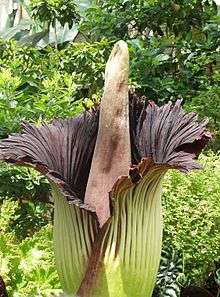
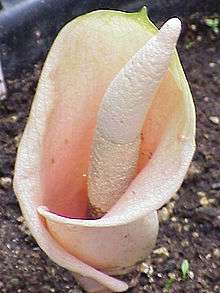
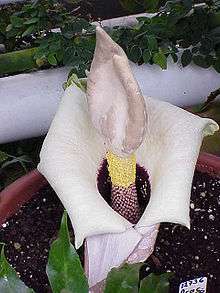
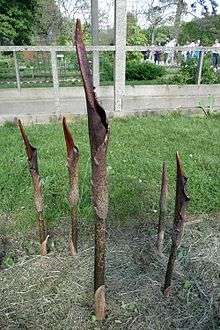
- Amorphophallus aberrans
- Amorphophallus abyssinicus
- Amorphophallus abyssinicus subsp. abyssinicus
- Amorphophallus abyssinicus subsp. akeassii
- Amorphophallus abyssinicus subsp. unyikae
- Amorphophallus albispathus
- Amorphophallus albus
- Amorphophallus amygdaloides
- Amorphophallus angolensis
- Amorphophallus angolensis subsp. angolensis
- Amorphophallus angolensis subsp. maculatus
- Amorphophallus angulatus
- Amorphophallus angustispathus
- Amorphophallus ankarana
- Amorphophallus annulifer
- Amorphophallus antsingyensis
- Amorphophallus aphyllus
- Amorphophallus asper
- Amorphophallus asterostigmatus
- Amorphophallus atrorubens
- Amorphophallus atroviridis
- Amorphophallus barthlottii
- Amorphophallus baumannii
- Amorphophallus beccarii
- Amorphophallus becquaertii
- Amorphophallus bonaccordensis
- Amorphophallus borneensis
- Amorphophallus boyceanus
- Amorphophallus brachyphyllus
- Amorphophallus brevispathus
- Amorphophallus bufo
- Amorphophallus bulbifer
- Amorphophallus calabaricus
- Amorphophallus calabaricus subsp. calabaricus
- Amorphophallus calabaricus subsp. mayoi
- Amorphophallus canaliculatus
- Amorphophallus carneus
- Amorphophallus chlorospathus
- Amorphophallus cicatricifer
- Amorphophallus cirrifer
- Amorphophallus coaetaneus
- Amorphophallus commutatus
- Amorphophallus consimilis
- Amorphophallus corrugatus
- Amorphophallus costatus
- Amorphophallus coudercii
- Amorphophallus cruddasianus
- Amorphophallus curvistylis
- Amorphophallus dactylifer
- Amorphophallus declinatus
- Amorphophallus decus-silvae : West-Java giant amorphophallus
- Amorphophallus discophorus
- Amorphophallus dracontioides
- Amorphophallus dunnii
- Amorphophallus dzuii
- Amorphophilus eburneus
- Amorphophilus echinatus
- Amorphophallus eichleri
- Amorphophallus elatus
- Amorphophallus elegans
- Amorphophallus elliottii
- Amorphophallus excentricus
- Amorphophallus forbesii
- Amorphophallus galbra
- Amorphophallus gallaensis
- Amorphophallus gigas : Sumatra giant amorphophallus
- Amorphophallus gliruroides
- Amorphophallus glossophyllus
- Amorphophallus goetzei
- Amorphophallus gomboczianus
- Amorphophallus gracilior
- Amorphophallus gracilis
- Amorphophallus haematospadix
- Amorphophallus harmandii
- Amorphophallus hayi
- Amorphophallus henryi : Taiwan amorphophallus
- Amorphophallus hetterscheidii
- Amorphophallus hewittii
- Amorphophallus hildebrandtii
- Amorphophallus hirsutus
- Amorphophallus hirtus
- Amorphophallus hohenackeri
- Amorphophallus hottae
- Amorphophallus impressus
- Amorphophallus incurvatus
- Amorphophallus infundibuliformis
- Amorphophallus interruptus
- Amorphophallus johnsonii
- Amorphophallus kachinensis
- Amorphophallus kiusianus
- Amorphophallus konjac : Devil's tongue, elephant foot, elephant-yam, leopard palm, snake palm, umbrella arum, voodoo lily
- Amorphophallus konkanensis
- Amorphophallus koratensis
- Amorphophallus krausei
- Amorphophallus lambii
- Amorphophallus lanuginosus
- Amorphophallus laoticus
- Amorphophallus lewallei
- Amorphophallus linearis
- Amorphophallus linguiformis
- Amorphophallus longicornus
- Amorphophallus longiconnectivus
- Amorphophallus longispathaceus
- Amorphophallus longistylus
- Amorphophallus longituberosus
- Amorphophallus luzoniensis
- Amorphophallus lyratus
- Amorphophallus macrorhizus
- Amorphophallus manta
- Amorphophallus margaritifer
- Amorphophallus margretae
- Amorphophallus maximus
- Amorphophallus maximus subsp. fischeri
- Amorphophallus maximus subsp. maximus
- Amorphophallus maxwellii
- Amorphophallus mekongensis
- Amorphophallus merrillii
- Amorphophallus mildbraedii
- Amorphophallus minor
- Amorphophallus mossambicensis
- Amorphophallus muelleri
- Amorphophallus mullendersii
- Amorphophallus mysorensis
- Amorphophallus nanus
- Amorphophallus napalensis
- Amorphophallus napiger
- Amorphophallus nicolsonianus
- Amorphophallus obovoideus
- Amorphophallus obscurus
- Amorphophallus ochroleucus
- Amorphophallus opertus
- Amorphophallus paeoniifolius : Whitespot giant arum, elephant yam
- Amorphophallus palawanensis
- Amorphophallus parvulus
- Amorphophallus paucisectus
- Amorphophallus pendulus : Brunei amorphophallus
- Amorphophallus perakensis
- Amorphophallus perrieri
- Amorphophallus pilosus
- Amorphophallus plicatus
- Amorphophallus polyanthus
- Amorphophallus prainii
- Amorphophallus preussii
- Amorphophallus purpurascens
- Amorphophallus pusillus
- Amorphophallus putii
- Amorphophallus pygmaeus
- Amorphophallus rhizomatosus
- Amorphophallus richardsiae
- Amorphophallus rostratus
- Amorphophallus rugosus
- Amorphophallus sagittarius
- Amorphophallus salmoneus
- Amorphophallus saraburiensis
- Amorphophallus saururus
- Amorphophallus scaber
- Amorphophallus scutatus
- Amorphophallus sizemorae
- Amorphophallus smithsonianus
- Amorphophallus sparsiflorus
- Amorphophallus spectabilis
- Amorphophallus staudtii
- Amorphophallus stipitatus
- Amorphophallus stuhlmannii
- Amorphophallus subsymbiformis
- Amorphophallus sumawongii
- Amorphophallus sylvaticus
- Amorphophallus symonianus
- Amorphophallus synandrifer
- Amorphophallus taurostigma
- Amorphophallus tenuispadix
- Amorphophallus tenuistylis
- Amorphophallus teuszii
- Amorphophallus tinekeae
- Amorphophallus titanum : Titan arum, krubi (largest flower structure on earth)
- Amorphophallus tonkinensis
- Amorphophallus variabilis
- Amorphophallus venustus
- Amorphophallus verticillatus
- Amorphophallus yuloensis
- Amorphophallus yunnanensis : Kerri's giant arum
- Amorphophallus zengianus
- Amorphophallus zenkeri
- Amorphophallus zenkeri subsp. mannii
- Amorphophallus zenkeri subsp. zenkeri
References
- Kew World Checklist of Selected Plant Families
- Sedayu, A., C. M. Eurlings, Gravendeel, B., & Hetterscheid, W. (2010). Morphological character evolution of Amorphophallus (Araceae) based on a combined phylogenetic analysis of trnL, rbcL and LEAFY second intron sequences. Botanical Studies, 51, 473–490.
- "Robert L. Freedman, The famine foods database". Archived from the original on 2009-12-21. Retrieved 2009-11-06.
- Hetterscheid, W., & Ittenbach, S. (1990). Everything you always wanted to know about Amorphophallus but were afraid to stick your nose into! Aroideana, 19, 17-20.
- "Thousands line up to see huge stinky flower" (video). Reuters Editors' Picks. Reuters. 30 September 2015. Retrieved 30 September 2015.
Chicago's floral celebrity is over four feet tall, incredibly rare, and smells like death
- "Voodoo Lily, Amorphophallus konjac". Master Gardener Program. Retrieved 2018-01-18.
- "Pacific Bulb Society | Sauromatum". pacificbulbsociety.org. Retrieved 2018-01-18.
- Hetterscheid, W.L.A. 1994. Preliminary taxonomy and morphology of Amorphophallus Blume ex Decaisne (Araceae). In: M.M. Serebreyanyi (ed.), Proc. Moscow Aroid Conference 1992: 35-48. Moscow.
- Hetterscheid, W.L.A. & G.J.C.M. v. Vliet, 1996. Amorphophallus, giant from the forest. CITES/C&M, 2(4): 86-96.
External links
| Wikimedia Commons has media related to Amorphophallus. |
| Wikispecies has information related to Amorphophallus |
- List of Amorphophallus species with photos from the International Aroid Society
- CATE genus page
- Amorphophallus in Brunken, U., Schmidt, M., Dressler, S., Janssen, T., Thiombiano, A. & Zizka, G. 2008. West African plants - A Photo Guide. Forschungsinstitut Senckenberg, Frankfurt/Main.